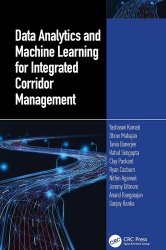 Название: Data Analytics and Machine Learning for Integrated Corridor Management
Название: Data Analytics and Machine Learning for Integrated Corridor ManagementАвтор: Yashaswi Karnati, Dhruv Mahajan, Tania Banerjee, Rahul Sengupta, Clay Packard, Ryan Casburn
Издательство: CRC Press
Год: 2025
Страниц: 242
Язык: английский
Формат: pdf (true), epub
Размер: 33.4 MB
In an era defined by rapid urbanization and ever-increasing mobility demands, effective transportation management is paramount. This book takes readers on a journey through the intricate web of contemporary transportation systems, offering unparalleled insights into the strategies, technologies, and methodologies shaping the movement of people and goods in urban landscapes. From the fundamental principles of traffic signal dynamics to the cutting-edge applications of Machine Learning, each chapter of this comprehensive guide unveils essential aspects of modern transportation management systems. Chapter by chapter, readers are immersed in the complexities of traffic signal coordination, corridor management, data-driven decision-making, and the integration of advanced technologies. Closing with chapters on modeling measures of effectiveness and computational signal timing optimization, the guide equips readers with the knowledge and tools needed to navigate the complexities of modern transportation management systems. With insights into traffic data visualization and operational performance measures, this book empowers traffic engineers and administrators to design 21st-century signal policies that optimize mobility, enhance safety, and shape the future of urban transportation.
The advent of Machine Learning has revolutionized data analysis, pattern recognition, and predictive modeling across various domains, including transportation and traffic management. Among the myriad of techniques, clustering, outlier detection, and neural networks stand out for their ability to uncover patterns, identify anomalies, and predict outcomes from complex datasets. This chapter presents a brief explanation of these techniques, emphasizing their application to traffic data analysis and the unique challenges and opportunities they present.
Clustering, a foundational unsupervised learning technique, is pivotal in identifying natural groupings in data, enabling meaningful segmentation and analysis without prior labeling. This chapter covers key clustering algorithms such as K-Means and hierarchical clustering, alongside distance metrics and methods to assess clustering quality. The discussion extends to the application of clustering in summarizing traffic intersection performance, highlighting its utility in managing vast amounts of traffic signal data.
Outlier detection, or anomaly detection, plays a crucial role in ensuring data integrity and enhancing model performance by identifying data points that significantly deviate from the norm. This section explores both supervised and unsupervised approaches to outlier detection, with a focus on its importance in detecting traffic interruptions and improving road network management.
Neural networks, with their ability to model complex relationships through layers of interconnected units, have seen widespread adoption in processing traffic data. From basic feed-forward networks to advanced architectures like recurrent neural networks (RNNs), long short-term memory networks (LSTM) , and transformers, this chapter examines how these models can predict traffic states, optimize signal timing, and contribute to effective traffic management solutions.
We have developed a visualization module that allows the user to derive trends and hotspots in their city using the modules described in the previous section. Our system is implemented using a variety of software technologies based on Python, Elixir, and Angular. We have also used libraries such as NumPy, Scikit-Learn and Pandas. At the lowest level the monitoring module collects data from a large number of intersections. The module allows for performing collection in real time or at regular intervals. This data is stored in a database. A multi-threaded software layer based on Elixir and Python is used to develop all of our algorithm implementation for each of the modules described in the previous section. This allows for fault tolerance and seamless scalability in presence of additional computational resources.
Скачать Data Analytics and Machine Learning for Integrated Corridor Management
[related-news] [/related-news]
Комментарии 0
Комментариев пока нет. Стань первым!















